Your cart is currently empty!

How to Create Effective Website Content That Engages Your Readers (10 Tips)
Reading Time: 12 minutesAuthor:
In this guide, we’ll explore ten different tips that can help you create effective website content. Using these methods, you’ll be able to attract new readers and engage your existing ones.
There are almost two billion websites on the internet today. It can be challenging to stand apart from other sites and maintain your readers’ interest with so much competition. If you fail to do so, you can quickly lose your fanbase and conversions.
However, you can use the following tips to improve your website and make it rank on the web. You can attract and keep new users by focusing on your readers, Search Engine Optimization (SEO), and content.
Let’s get started!
1. Use the Outside-In Approach
There are two strategies that businesses commonly use to engage with their users: the inside-out or the outside-in approaches. The former option focuses on a company’s strengths and leverages them to appeal to its customers.
However, we recommend using the outside-in approach. This asks you to consider every element of your business from your customers’ perspective. Applying this principle to writing effective website content means considering your audience first in everything you create.
For example, you will first need to consider potential customer problems and tailor your content to address them. As such, you’ll need to understand your audience before you even put pen to paper.
You can start by creating a customer avatar. This is a profile of your target client and includes many of the following elements:
- Demographics (such as age, nationality, and educational background)
- Characteristics (such as desires, interests, and goals)
- The customer’s pain (the problem they need to solve)
- The customer’s gain (how solving their problem benefits them)
If you don’t know much about your existing customers, you may need to do some research. For example, you can survey your current readers using a tool such as Ask Your Target Market (AYTM):

This tool enables you to create custom surveys and share them with your readers. Then, you can analyze the results to develop your customer avatar. AYTM also has various handy features, such as visualization graphs, market research tools, and statistical reports.
Once you’ve defined your ideal reader, you can write your website content to appeal to their wants, needs, and goals. As such, your written work will be more likely to catch their attention and convert them into customers.
2. Use SEO to Get Found
You can write the most incredible content in the world. However, if no one can find your website, then it will all go to waste.
Therefore, we recommend spending some time on your Search Engine Optimization (SEO) strategy. This method makes your content appear higher on the search engine results pages. As such, users are more likely to find your articles and your business.
First, you’ll need to understand what your potential users are looking for online. What’s their search intent? You can do this by using the keyword research steps described in our post, A Keyword Research Guide for the Rest of Us. This helps you find phrases your readers seek in Google and other search engines.
For example, you might be a digital marketing agency. As such, you’ll probably want users to find you if they’re looking for “digital marketing company” or similar keywords.
To get started with keyword research, you can use the Google Keyword Planner tool:
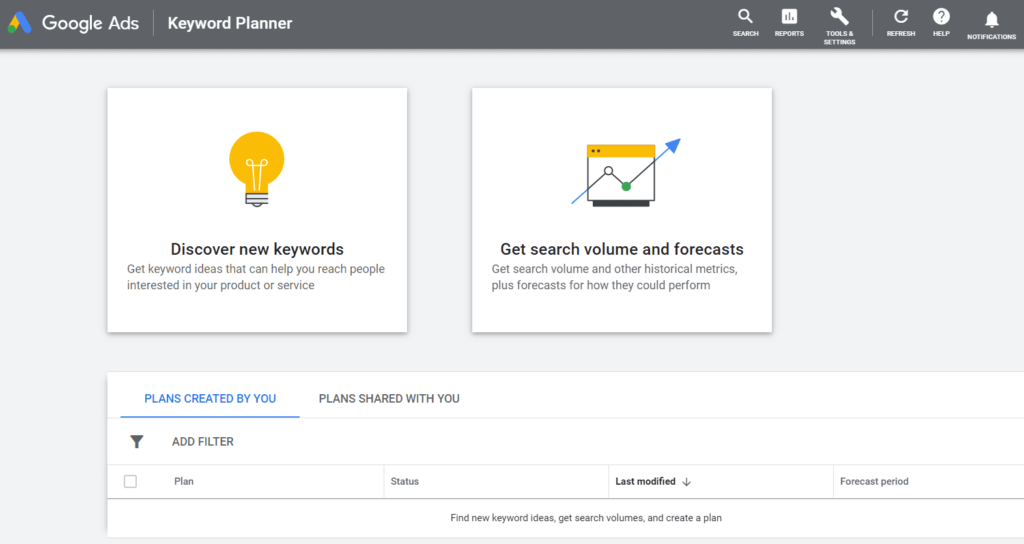
You can type in a key phrase and see its monthly search volume and competition for Google ads. The tool will also show you related keywords and their statistics:
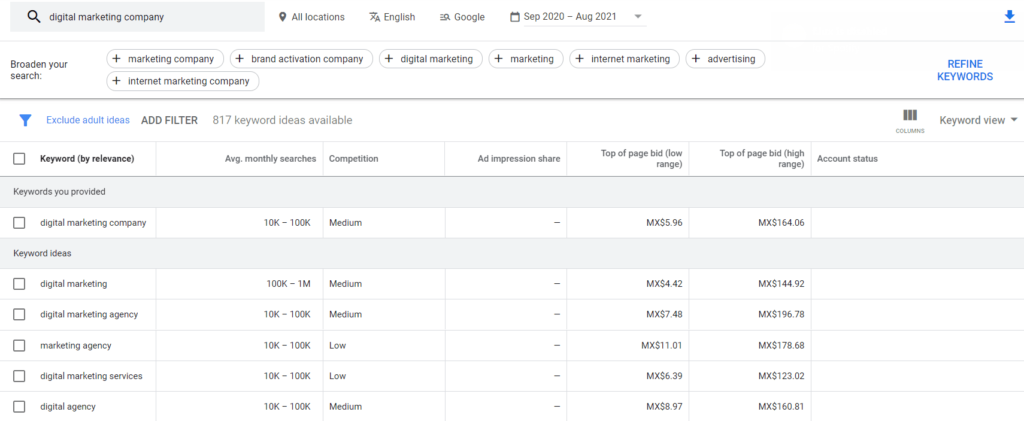
You’ll probably want to aim for keywords with moderately high search volumes but lower levels of competitiveness. Until you have a prominent website, you may struggle to compete with established sites.
Additionally, you can use a tool such as Google Trends to see how your chosen keywords have performed over time:
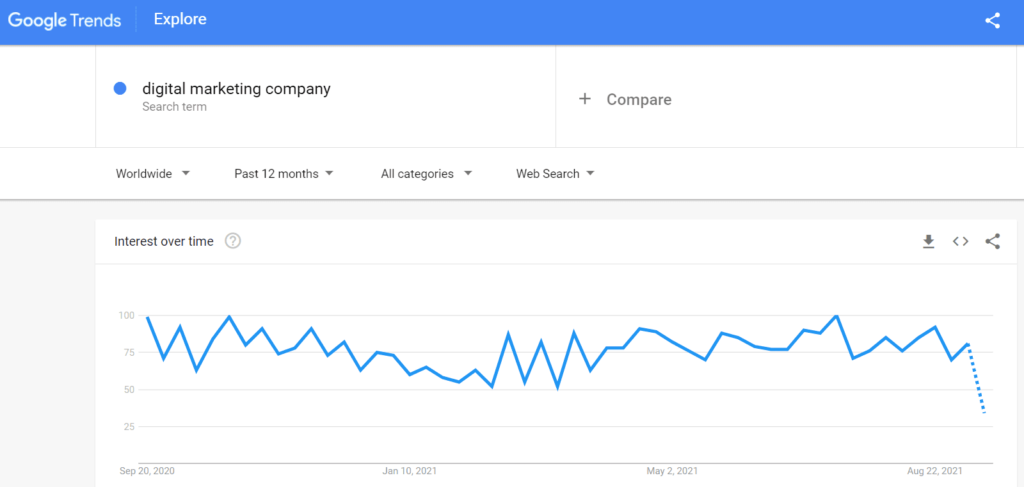
If your phase is on the decline, it might be time to look for an alternative. However, if it’s gaining popularity, designing content using that keyword could be worthwhile.
Make a list of the keywords you want to cover with your content. In the next section, we’ll discuss how you can use them to make your site more visible.
For a more detailed look at creating effective website content, review our blog post How to Write Content That Ranks.
3. Use an Outline for Your Content
Consistent content is important for your website branding. Customers may be confused about what your business represents if you don’t have a clear voice and style. Using outlines can help you refine your content.
You may like to define a clear structure for your articles. For example, you may want to use uniform headings such as “Conclusion” for the last few paragraphs of every blog. You might also choose a standard length for your introductions and overall articles.
You should also consider SEO in your content outlines. This is where you can utilize those keywords you found earlier.
There are various places you can include your keywords throughout your posts:
- Throughout the content
- In the meta descriptions
- In the image alt descriptions
- In the post URLs
- In your post headings and subheadings
You can use a handy plugin like Yoast SEO to refine your SEO approach:

You can use a free or premium version of this plugin. It integrates with your WordPress site, and you can enter your chosen keyword. Then, Yoast SEO will tell you any improvements that you should make in your content:

When working with Yoast SEO, you want most or all of the lights to be green. They show that your content is optimized for your chosen keyword.
You may also like to include synonyms of your keywords throughout your text. Doing so can enable your content to rank for multiple search terms. For example, you might use both “digital marketing company” and “digital marketing agency.”
You can include these synonyms in your article outlines and other stylistic guidelines. Then, you can share them with your entire team to maintain consistency across the board.
4. Utilize the Problem/Solution Structure in Your Posts
We recommend using the problem/solution structure for more effective website content. This approach will appeal to readers by identifying issues they might have. Then, you provide clear and actionable fixes for their problems.
For example, many articles use problem/solution structures in their introductions:

However, your posts can also use the problem/solution structure. You may use it within paragraphs or structure your entire article to present the issue and then solve it. You may like to try a few different styles to see which ones work best for your content.
This approach can be practical because it appeals personally to your readers. It shows them that you understand their problems and have the expertise to solve them.
However, you will first need to understand your readers before identifying and fixing their problems. You may feel lost with your content if you haven’t yet created your customer avatar and researched your keywords.
You may also need sufficient social proof to offer satisfying solutions to your readers. Otherwise, they may doubt whether they should trust your content.
As such, you should consider including quality references and testimonials on your website. These elements can show your readers that you are respected within your industry and can provide valuable advice:

Additionally, you can outline your expertise on your site’s About page. We also recommend using reliable references. However, we’ll cover their importance later in this article.
5. Write for People, Not Bots
Earlier, we talked about the importance of SEO and including keywords in your content. However, there are some dangers if you focus too hard on this strategy.
For instance, you may start creating articles stuffed with keywords and related phrases. They may become unreadable and overwhelming for your users. Although they may be acceptable for SEO purposes, you will have lost the human element that makes your content appealing to readers.
As such, we recommend exercising caution with your keyword strategy. If you’re using Yoast SEO, it will usually alert you if you’re overusing your keyphrase. You may also like to read your content aloud to see if it sounds natural.
Moreover, you should consider the readability of your text. Most people scan articles rather than read them in full. In fact, the average person only consumes 28 percent of a page’s content.
Therefore, giant walls of text are usually off-putting for readers. They will find it challenging to understand your content and take value from it.
There are a few strategies you can use to make your content more effective:
- Use shorter and simpler sentences
- Replace jargon and complicated words with simple vocabulary
- Create more white space with shorter paragraphs
- Break up text with headings
- Use images and videos throughout your articles
- Use lists
You can also use a tool such as Readable to improve your text:
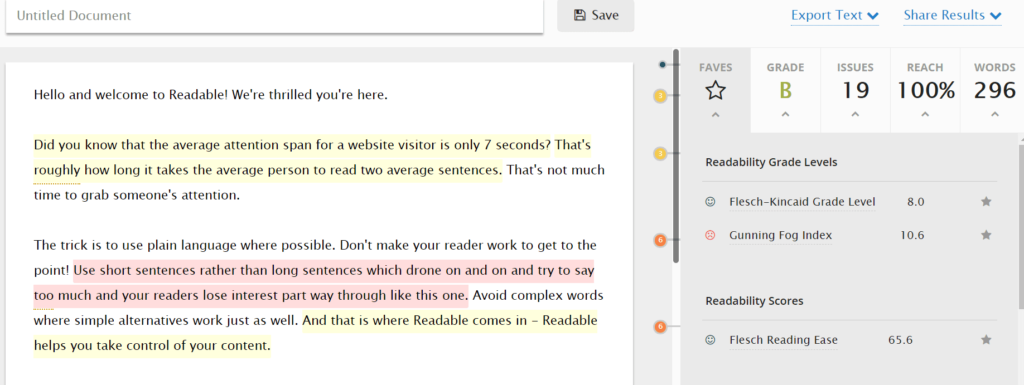
It highlights problems such as long sentences, complicated vocabulary, and the use of the passive voice. Readable also scores your content according to various readability criteria, such as the Flesch-Kincaid Grade Level.
If you use the app’s premium version, it can also make corrections for you. Therefore, you can simplify your text and make it more appealing for your readers.
6. Remember That Pictures Tell and Copy Sells
Most effective website content uses a mixture of pictures and text. Visual elements can concisely explain concepts that would be convoluted in written form. As such, you can use them together when creating your sales copy.
Up to 65 percent of people are visual learners. If you try to explain or sell to them with text alone, they may miss some of the most important features or benefits. Alternatively, they may simply feel bored and stop reading.
You may feel tempted to use stock images in your sales copy or elsewhere on your site. However, they tend to perform worse when compared to legitimate photographs from your organization. Therefore, you should aim to use authentic graphics.
Furthermore, you should consider optimizing your images before uploading them to your website. This means making their file sizes smaller so that your site pages can load faster. Otherwise, you may turn potential readers away with a slow website.
You can use a plugin such as Smush to compress images on your WordPress site:
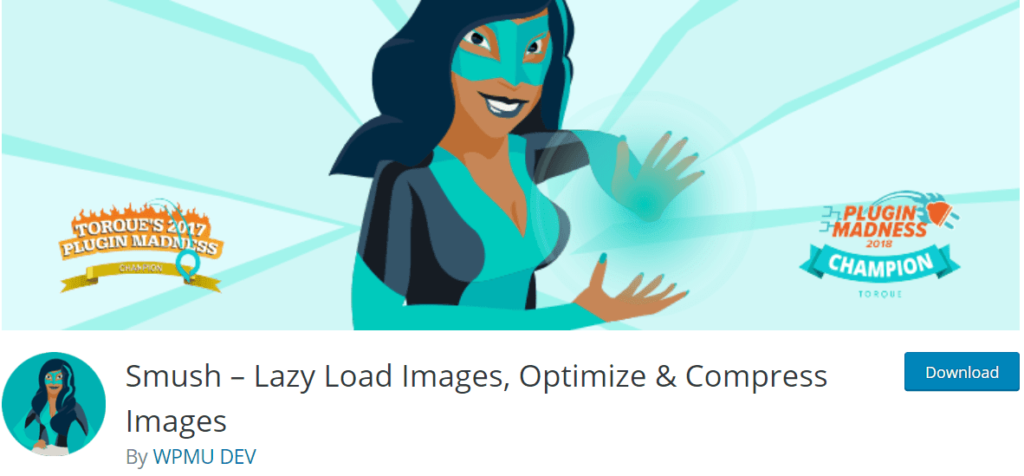
Smush can compress images without reducing their quality. You can optimize up to 50 pictures at once and choose custom sizes to suit your needs.
Additionally, this plugin supports lazy loading. This feature prevents images from loading until readers encounter them on the page. As such, it helps your website to load faster when users first land on it.
7. Ask for Action From Your Readers
Reader engagement is one of the easiest ways to measure if your website content is effective. If your followers comment on your articles and ask questions, they may return to your site to see the answers.
You can encourage your readers to engage by using Calls to Action (CTAs). These are active phrases that ask users to complete actions. Businesses also commonly use CTAs to encourage sales and move customers through the sales funnel.
For example, you may prompt your readers to “Learn More” by clicking on a CTA button:

When designing your CTA, there are a few factors you should consider:
- Contrast: Using a different color for your CTA can make it stand out from the rest of the text.
- Benefits: Outlining the benefits of clicking on your CTA can motivate readers to do it.
- Action-based language: Using actionable text in your CTA shows your readers precisely what you want them to do.
- Length: Short and clear CTAs are usually the most effective ones.
- Urgency: Using active language and exclamation points can incentivize your readers to follow through.
You can make CTA buttons using a free tool such as the Da Button Factory from ClickMinded:

You can enter your CTA copy into the tool and choose your font and other styling options. Then, you can opt to download the CTA button or copy the embed code to insert it directly into your site.
You may like to design a few different CTAs and then check their effectiveness with A/B testing. This method pits two options against each other and measures clicks and conversions for each one. Then, you can analyze the data to see which CTA is best for your business.
8. Support Your Claims
If your readers don’t find you credible, they are unlikely to trust your content or buy your products. As such, supporting your claims with evidence and links to reputable sources is essential.
For example, if you’re quoting statistics or explaining a theory, you should consider linking to a reliable source. Otherwise, your readers won’t know if you’re telling the truth or making up facts.
External links are also crucial for SEO purposes. Search engines such as Google evaluate which sites you are linking to in your content. If these websites are reputable, the links can improve your rankings in search engine results pages.
One factor that determines a website’s credibility is its Domain Authority (DA). Sites with high DAs are regarded as authoritative sources in their respective fields. As such, you should link them as much as possible.
You can check the DA of websites using tools such as Moz:
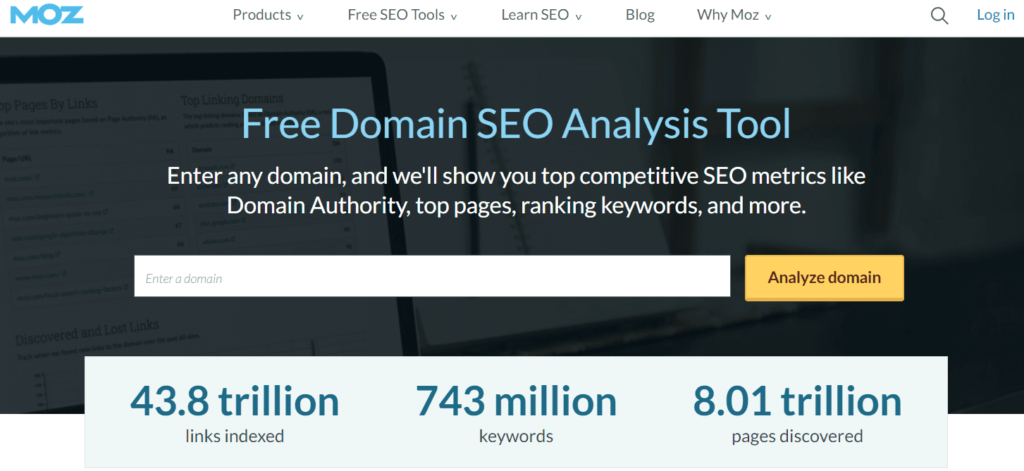
You can enter a URL, and Moz will return a DA score from 0 to 100. Higher scores correspond to more reputable websites. You can also use this tool to monitor the progress of your own site as you work on your SEO strategy.
Furthermore, you should consider including internal links throughout your content. These URLs point to other articles, posts, or pages on your website. These links are also ranking factors for SEO purposes, so you shouldn’t neglect them.
Moreover, internal links can direct your readers to more relevant content. Therefore, they are more likely to spend more time on your site and possibly purchase your products or services.
9. Edit Everything, Then Edit It Some More
Once you’ve gone through the time-consuming process of writing your content, you may not want to look at it anymore. It may be tempting to publish and get the task over and done with simply. However, this can be a critical mistake for your business.
If your text is poorly written and riddled with errors, it can quickly turn away potential readers. It will also look unprofessional and can reflect poorly on your company. Therefore, editing should be an unmissable step of your content creation process.
You can use a few different editing techniques to catch errors in your content. For example, you can read your articles out loud to see if they sound natural. This method can also help you pick up unnecessary words in your sentences. Additionally, you can record these readings to listen back later.
If you use WordPress or another platform, you might like to read your articles using the front-end preview. It shows you how your posts will look when published. This method can be less distracting than the back end with its editing tools and other elements on the page.
Moreover, if you have a larger team, you may like to use two editors or utilize a checker. This method can account for human error.
However, you don’t have to handle all editing on your own. You can use an editing tool such as Grammarly to help you with the process:
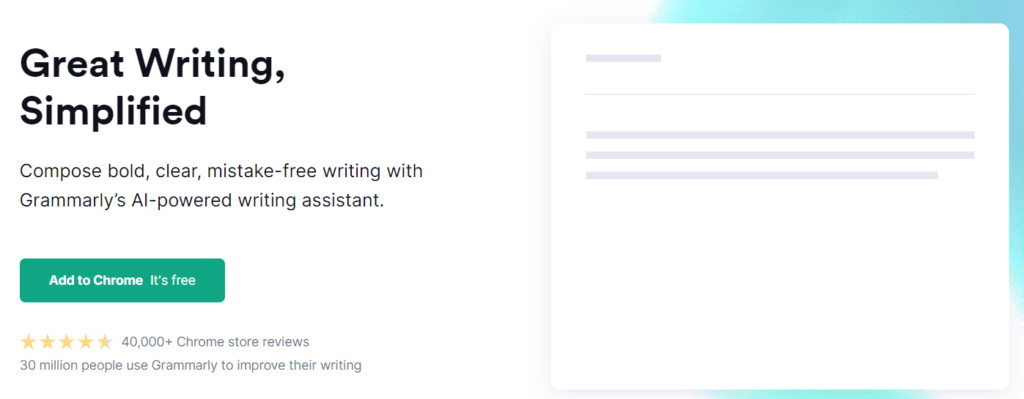
You can add text directly to the Grammarly interface or enable the add-on in your browser. Then, the program can alert you to correctness, clarity, engagement, and delivery issues. There is also a premium version to refine your written content further.
10. Monitor Your Site’s Performance
Finally, you may decide to overhaul your entire content strategy by following the tips in this article. However, you’ll need to know whether the new methods are working.
For example, finding out if you have increased traffic or conversions will be beneficial. You can also pinpoint the most effective conversion and tailor your other articles accordingly.
You can monitor and analyze your site’s performance using Google Analytics:
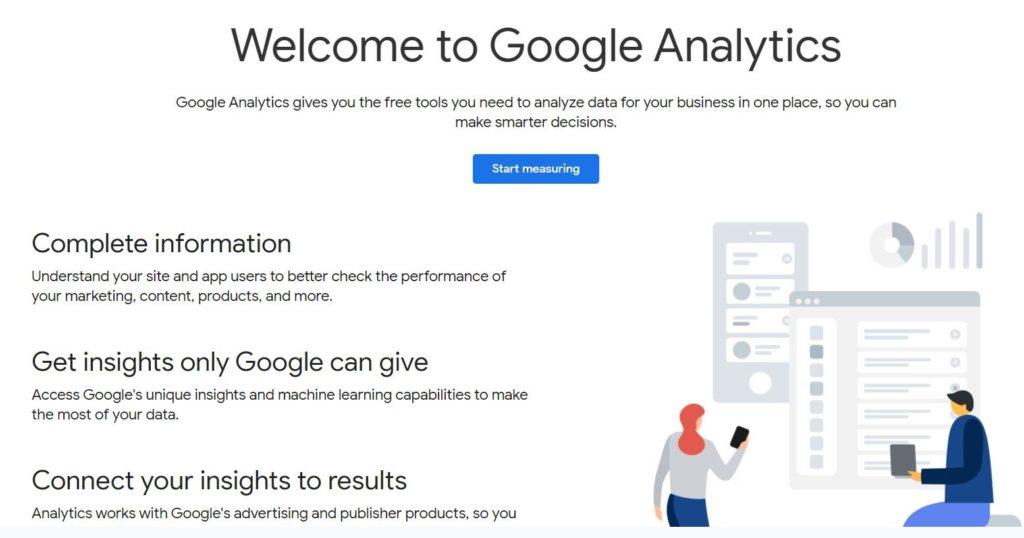
You’ll need to set up a free account and connect your business website to the Google Analytics platform. Then, it can start providing data and insights such as conversions, revenue potential, interactions with your content, and more.
If you want to measure the effectiveness of your SEO strategies, you can also use Google Search Console:
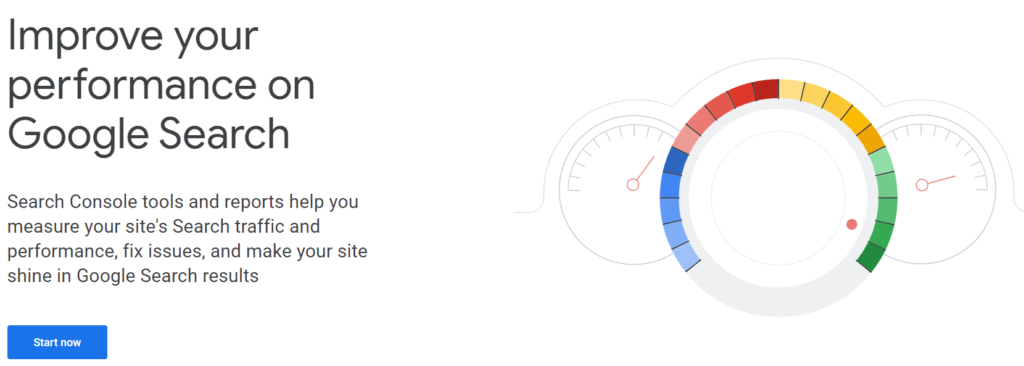
This shows you which keywords your site ranks for and which ones bring readers to your site. Google will also use its data to let you know if you have issues on your site and advise you on fixing them. You can use its analysis to tailor your SEO and content strategies further.
Once you understand which strategies are working for your new content, you can go back and optimize your old articles. Although this process can be time-consuming, it can ensure that readers will get value from even the oldest posts in your archives.
Conclusion – How to Create Effective Website Content
Many poor-quality websites exist only for SEO purposes. However, your site doesn’t have to be one of them. Planning and creating effective website content for your readers can keep them loyal to your blog and business.
Put your readers first and ensure that your content is engaging and factually correct with sources and relevant images. You will set yourself up for success by using article outlines and the problem/solution structure in your writing. Furthermore, prioritize your editing and analytical processes to monitor if your strategies are working.
Do you have any questions about creating effective website content? Contact us! We’d be happy to chat.
Related Posts
-
Don’t Shout About Features, Connect With Solutions
Learn how marketing that connects with best customers breaks through the noise and drives growth.
-
Write Better Headlines
Discover 10 tips to craft compelling headlines that captivate readers and boost engagement.
-
Principles for Lasting Connections
A practical exploration of relationship marketing.
Author: James Hipkin
Since 2010, James Hipkin has built his clients’ businesses with digital marketing. Today, James is passionate about websites and helping the rest of us understand online marketing. His customers value his jargon-free, common-sense approach. “James explains the ins and outs of digital marketing in ways that make sense.”
Use this link to book a meeting time with James.

